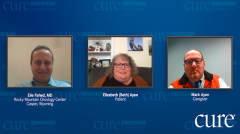
Beth’s Experience with Chemotherapy for Multiple Myeloma
Beth compares her experiences with two multiple myeloma chemotherapy regimens, and Mark shares thoughts on Beth’s remission.
Episodes in this series

Elie Fahed, MD: At that time, we discussed doing first-line chemotherapy 12 years after your transplant. Do you remember the regimen?
Elizabeth Ayen: Yeah.
Elie Fahed, MD: We were doing Velcade [bortezomib], Cytoxan [cyclophosphamide] and Decadron [dexamethasone].
Elizabeth Ayen: Right.
Elie Fahed, MD: How was your experience with this regimen compared with the old VAD [vincristine, doxorubicin, dexamethasone], which consists of vincristine, Adriamycin, and Decadron? The V is not the same, for our listeners. In the old regimen, V stood for vincristine. Now we have Velcade [bortezomib] as a new proteasome inhibitor used for treatment for myeloma.
Elizabeth Ayen: The treatment was really easy compared with any of that. The biggest issue with Velcade [bortezomib] was the neuropathy that started up. We went on that treatment for about a year, Dr Fahed, if I remember correctly.
Elie Fahed, MD: We did it for more than a year, but do you remember if we gave it to you via IV [intravenous] or subcutaneous injection?
Elizabeth Ayen: It was a subcutaneous injection.
Elie Fahed, MD: Good, because in the early days of Velcade, it was approved as an intravenous solution, and over time they develop the subcutaneous injection. We found that it gave similar benefits and outcomes with way less neuropathy. I do not think I have used the IV form of Velcade [bortezomib] in a long time; it’s been more than eight or nine years. Every Velcade [bortezomib] I use now is subcutaneous, and we have less neuropathy. We still get neuropathy in patients, but much less. Do you have any residual toxicity or neuropathy, or did that stop when we finished the medication?
Elizabeth Ayen: You had concerns about it, and then we started just to discuss stopping the treatment, even though the Velcade [bortezomib] was still working. However, neuropathy was the concern, so we stopped it, as I said, more because of the neuropathy than because the Velcade [bortezomib] wasn’t working. I went a year after that with no treatment.
Elie Fahed, MD: You have what we call Velcade [bortezomib] intolerance, which refers to when neuropathy is a toxicity. It is a limiting factor, not your tumor becoming resistant. We will talk about that later. You are back on Velcade [bortezomib] right now, and another combination with Xpovio [selinexor], and it is working for you. It is important to note in the medical chart that sometimes medications can get stopped for different reasons. Sometimes the tumor becomes resistant, but sometimes we stop because of side effects. Mark, do you want to chime in and tell us about your experience at that time? If you are 10 years cancer-free, usually, you forget about myeloma. You tell yourself it is never going to come back. You say it was a bad memory and then the same nightmare started again when she started having bone pain again.
Mark Ayen: Even though the doctors in Colorado had told us, “Oh, if you make it 10 years, it’s never coming back. We are considering you cured,” in the back of my mind, I never really believed them. I always expected it to come back. The first diagnosis—when they told me she had two to three years to live—was a freaky experience, but by this time, she had lived 13 or 14 years, so I was not as concerned about the prognosis at this point because I just felt like clearly this was a demonstration that every myeloma patient is different. My wife is, apparently, extraordinary.
Elie Fahed, MD: Absolutely.
Mark Ayen: She was blowing everything out the window. I was just happy that the drugs this time around were much more tolerable and a lot easier for her to handle. We also had no children at home. It was a lot easier for me, as the caregiver, to just have one person to care for. Although it was disappointing. I would have liked to say, “Yeah, my wife has been cured, and she is moving on with her life,” but realistically, I was expecting it, to be honest.
Elie Fahed, MD: Deep inside you were afraid of, or you knew this was going to happen again one day. And eventually she started having rib pain and skull pain again.
Mark Ayen: The frustrating thing was that that rib pain had been going on for a couple of years, and she had been to several doctors about it early on, including a midnight emergency room visit while we were on vacation. The pain got so bad. No one was finding anything, and no one was looking into anything. Looking back, it was a little frustrating that no one found anything until it busted through the bone, and then we were able to get somewhere. I was relieved that someone was at least doing something at that point, and we were able to get her some relief. We were ready to move on.
Elie Fahed, MD: From a patient perspective, it is very important to listen to and believe in your body. If you are having pain in your ribs, just keep relaying that message to your doctor. Not every case is typical. People have different presentations, so it is important to be consistent. You know yourself much better than any physician, so you will be your own best advocate over time.
Elizabeth Ayen: Definitely.
This transcript was edited for clarity.

